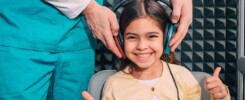When was the last time you were at a loud concert, or even enjoying your favorite song in the car or through headphones. Music releases endorphins—the brain’s chemical which signals feelings of well-being. While you were feeling the music it’s likely you weren’t considering the damaging affects you may be causing to your hearing. While many of us know that loud music can cause hearing damage, often when we are young we feel invincible and don’t consider the long term damage we may be self inflicting. Now, a new study illuminates noise induced hearing loss as a global issue of great proportions as it’s found that approximately one billion young people are at risk of hearing loss,
Hearing Loss- a global health issue
The World Health Organization (WHO) reports that there may be as much as 430 million people of all ages have loss of hearing globally. In the United States alone this number may be as much as 37.5 million for adults over 18, or one in eight people. There are many causes of hearing loss. Some of them can be cured by clearing earwax from the ear canal or removing a blockage. However around 90 percent of cases are sensorineural, which means the tiny hair-like cells of the inner ear have sustained damage. While we collect sound with our ears, it’s these tiny cells, called stereocilia, which must convert these audio waves into electrical impulses which can be received by the brain. There are many causes of sensorineural hearing loss, the most common being changes in the ear as we age. However other causes include impact to the head, chronic ear infections, environmental toxins, certain medications and ongoing health conditions which affect the integrity of cell health, such as diabetes, hypertension and cardiovascular disease.
Noise Induced Hearing Loss
The most common cause of hearing loss in younger people by far is caused by extreme exposure to noise. In fact, based on a study, published in BMJ Global Health, hearing loss may affect around one billion younger people worldwide. When sounds become too loud, they create vibrations loud enough to cause the cells of the inner ear to shatter against the cell walls that hold them- resulting in irreversible damage.
The loudness or volume of sound is measured in decibels and any decibel over 85 dBA and higher can damage the cells of the inner ear permanently. It’s not only the level of exposure but the length of exposure. At 85 dBA it can take eight hours of constant exposure for damage to occur. As the decibel level rises the exposure time quickly becomes shorter. In fact, for every increase of three decibels the exposure time is cut in half. At 88 dBA it only takes 4 hours, and at 91 dBA it only takes 2 hours. By the time the decibels reach 100 dBA permanent hearing damage can occur in around 15 minutes!
A Younger Generation of Hearing Damage
The Study published in BMJ examined participants aged 12 to 34 to determine the impact of unsafe listening practices. This included attending loud concerts and blasting music from headphones
“Unsafe listening practices are highly prevalent worldwide and may place over 1 billion young people at risk of hearing loss,” the authors of the study reported. “There is an urgent need to prioritize policy focused on safe listening.”
The Danger of Headphones
Perhaps one of the greatest causes of noise induced hearing loss for a younger generation is the use of headphones. Headphones can produce decibel levels which range from 75 dBA to 100 dBA. On the higher range of this volume capacity, hearing damage can occur in just 15 minutes. However, due to the seemingly never-ending supply of media, via streaming on the world wide web, younger people tend to listen for longer than ever before.
Listening Safer
Using headphones doesn’t have to cause damage. “A rough rule of thumb is, if you’re using earbuds, take them out and hold them away at arm’s length,” explains ear health researcher Sam Couth, from the University of Manchester in an article posted in the Washington Post. “And if you can still hear the music clearly at arm’s length, it’s too loud.” The key is keeping the volume no higher than 60 percent of the total volume and taking listening breaks every 30 to 60 minutes.
Hearing loss is irreversible but can be treated with hearing aids. To find out if you have hearing loss, schedule your next appointment with us today.


